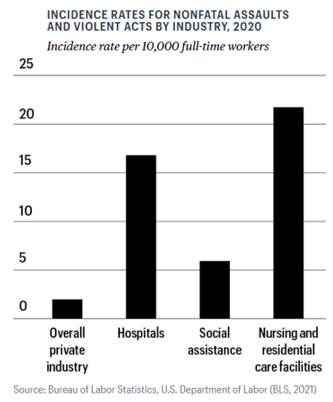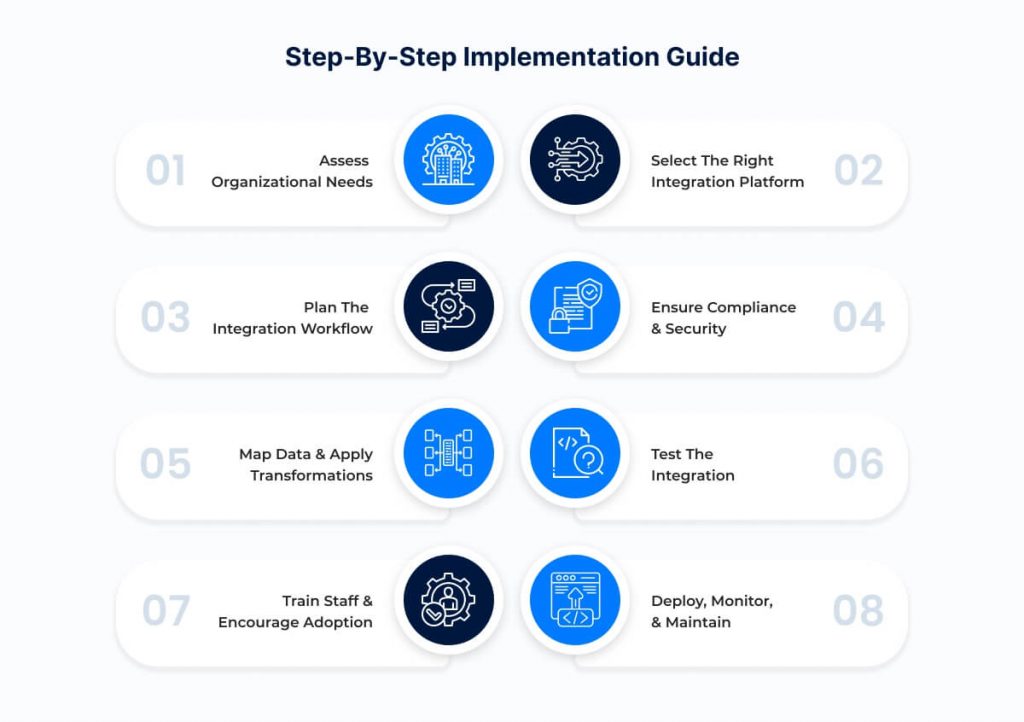Written by Joanne Byron,
BS, LPN, CCA, CHA, CHCO, CHBS, CHCM, CIFHA, CMDP, OHCC, ICDCT-CM/PCS
Patient safety directly relates to reducing mistakes. Increased job-related stress contributes to workforce burnout, a major contributing factor to unsafe practices. Unfortunately, our healthcare workforce faces unprecedented challenges: incidence of violence in the workplace, accelerated rates of burnout, and exposure to dangerous hazards. This article emphasizes the need to improve patient safety and outcomes through reducing staff burnout.
Introduction
Providing a safe environment instills confidence not only to the patients we serve, but for our workforce as well. According to the National Institutes of Health, a strong link exists between workforce wellness and patient safety. When healthcare workers are physically and mentally well, they are more likely to have the ability to focus and deliver safe and quality patient care. Therefore, we can conclude that a healthy workforce is necessary for a safe patient environment.
A positive patient and workforce safety culture has been shown to significantly improve a number of patient outcomes, including lower rates of surgical site infections, falls, and medication errors, according to the Patient Safety Network. In addition to specific health outcomes, patients report having better experiences with their care when the culture of patient safety is strong.
Although most healthcare organizations agree on the importance of safety culture, research this year focused heavily on the psychological factors surrounding culture, such as psychological safety, how to support healthcare workforce staff after an adverse event, and burnout. This is a challenge in today’s world.
Work Overload as a Contributing Factor
Causes of work overload in healthcare include time constraints; alert or alarm fatigue; new and hard-to-use technology, including EHRs; and cognitive strain, which, according to the American Medical Association (AMA), directly or indirectly causes 87.1% of medical errors—even though most safety interventions focus on training clinicians, whose knowledge and skill is responsible for only 12.8% of medical errors.
Assaults, Violence Contribute to Burnout
The passion most healthcare workers have can be overridden by the threat of on-the-job violence. And this doesn’t even account for the threats encountered getting to and from work!
According to the Bureau of Labor Statistics, there is a 63% increase in the rate of injuries from violent attacks against medical professionals from 2011 to 2018. And, according to a report by the Centers for Disease Control (CDC) and the Bureau of Labor Statistics (BLS), it is reported that:
- In 2020, health care and social assistance workers overall had an incidence rate of 10.3 (out of 10,000 full-time workers) for injuries resulting from assaults and violent acts by other persons.
- The rate for nursing and personal care facility workers was 21.8 per 10,000 full time workers for injuries caused by assaults and violent acts by others.
- This means that for every 10,000 full-time employees in nursing and personal care facilities, there were an average of 21.8 reported incidents of workplace violence.
- Data obtained from nurses (RNs/LPNs) in a major population-based study showed a rate of physical assaults at 13.2 per 100 nurses per year and at a rate of 38.8 per 100 nurses per year for non-physical violent events (threat, sexual harassment, verbal abuse).

As you can see, it is difficult to work your best under these circumstances. And even though some institutions may have a proper formal incident reporting system, there are still many incidents, especially in the forms of bullying, verbal abuse, and harassment that are never reported.
Most Vulnerable Workforce
The most vulnerable healthcare workers victimized are staff at emergency departments, especially nurses and paramedics, and staff directly involved with in-patient care.
What Patient Safety Is
When discussing “patient safety” in the context of this article, it may be helpful to quote definitions, examples and descriptions of what a safety culture is.
According to the American Nurses Association, a culture of safety describes the core values and behaviors that come about when there is collective and continuous commitment by organizational leadership, managers, and healthcare workers to emphasize safety over competing goals. The Joint Commission defines Safety Culture as the sum of what an organization is and does in the pursuit of safety.
From a global perspective, the World Health Organization states that patient safety is defined as “the absence of preventable harm to a patient and reduction of risk of unnecessary harm associated with health care to an acceptable minimum.” Within the broader health system context, it is “a framework of organized activities that creates cultures, processes, procedures, behaviors, technologies and environments in health care that consistently and sustainably lower risks, reduce the occurrence of avoidable harm, make error less likely and reduce impact of harm when it does occur.”
Is Burnout a Still Problem Now that COVID-19 is Behind Us?
The COVID pandemic is a major contributing factor to the overall burnout of health care workers. And, COVID continues to be a current infectious disease stressor to the healthcare workforce. According to the Centers for Disease Control (CDC), “Health worker jobs in the U.S. involve demanding and sometimes dangerous duties, including exposure to infectious diseases and violence from patients and their families. The COVID-19 pandemic presented even more stressors. These included a surge of patients, longer working hours, and shortages of supplies and protective equipment. Health workers are reporting feeling fatigue, loss, and grief at levels higher than before the pandemic.” The CDC reports:

Individuals who choose to work in healthcare often make personal sacrifices for their work. While the work can be rich with purpose and meaning, the demands on time and attention can be relentless to the point of being unhealthy for the healthcare worker. Leadership’s approach and commitment to patient safety has a significant impact on your organization’s culture. If leaders do not prioritize or actively foster a culture of safety, it can negatively affect staff engagement and commitment to patient safety practices. Strong and supportive leadership is crucial for implementing and maintaining a culture that prioritizes patient safety. Lack of support from upper management contributes to clinical staff burnout.
Burnout related to work stress is mainly seen as emotional exhaustion, depersonalization, and diminished sense of accomplishment. This manifests itself with mental and physical exhaustion and is demonstrated as a lack of commitment, inadequate support, or insufficient prioritization of safety measures by leadership and staff. This can result in a higher likelihood of medical errors and adverse events occurring.
In healthcare organizations, patient and workforce safety culture are founded on how well teams work together, how supportive leadership and managers are of patient and workforce safety, how staff report events and near misses, and how teams and leaders respond to events. A weak organizational culture can also discourage staff from reporting incidents or speaking out about potential safety concerns further compromising patient safety.
Focusing efforts on a sound and sustained safety culture will lead to and support better outcomes in patient healthcare and safer working conditions for healthcare workers.
Address Patient Safety and Volunteer Staff Burnout
Don’t overlook the important role of your volunteers! Volunteers have a potential negative impact on patient care when these important members of your team experience high levels of burnout. This can lead to decreased attention to detail, potential errors, and compromised quality of care due to exhaustion and reduced motivation. Although they are unpaid staff, they still require orientation and training. When their importance is overlooked and minimized, it can contribute to burnout, making them more prone to mistakes, overlook important details, or have reduced responsiveness, potentially affecting patient safety. Factors like unclear expectations, excessive workload, lack of support from leadership, inadequate training, and feeling undervalued can contribute to volunteer burnout.
Emotional exhaustion, decreased engagement, increased absenteeism, irritability, and feeling overwhelmed are common signs of volunteer burnout. Implement systems to identify early signs of burnout in volunteers and provide necessary support or adjustments to their roles. Routine skills testing, annual HIPAA and compliance training should be included in your volunteer program.
Conclusion
The purpose of patient safety is to reduce risks, errors and harm that can occur to patients while receiving medical care, which is part of the huge patient quality emphasis currently stressed in the United States and globally. As the world faces evolving and new challenges, it can be difficult to provide an infrastructure to respond with consistent, effective practices deployed by a workforce that is properly equipped, financially and emotionally supported.
The most effective approach to envision the promotion of a patient safety culture is a multifaceted approach of interventions established at the top. Additional reading and resources to review are:
- Binghamton University October 2024 Preventing Burnout in Healthcare: A Guide for Aspiring Professionals
- HHS Surgeon General “Addressing Health Worker Burnout”
- National Library of Medicine Articles
- Pattern of Violence Among Healthcare Workers in a Tertiary Care Government Hospital and a Multi-Specialty Private Hospital in Sagar, India: A Cross-Sectional Study
- Promoting a culture of safety as a patient safety strategy
- Strategies and Interventions to Improve Healthcare Professionals’ Well-Being and Reduce Burnout
- AHRQ 2022 Surveys on Patient Safety Culture Hospital Report
About the Author and AIHC
The author, Joanne Byron, shares her clinical, consulting, auditing and educational experience by serving as the Board Chair and overseeing the AIHC Volunteer Education Committee. She is also a volunteer hospice nurse, hospice hands-on-care volunteer and End of Life Doula.
American Institute of Healthcare Compliance (AIHCR) is a non-profit healthcare training organization and a licensing/certification partner with CMS. Please visit our online store listing current training and certification offerings.
Copyright © 2024 American Institute of Healthcare Compliance All Rights Reserved
The post Building a Culture of Patient Safety Starts with Reducing Staff Burnout appeared first on American Institute of Healthcare Compliance.






